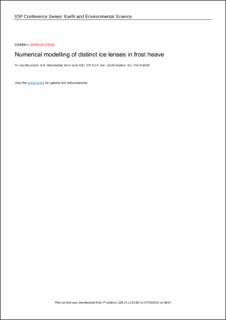| dc.contributor.author | Ghoreishian Amiri, Seyed Ali | |
| dc.contributor.author | Grimstad, Gustav | |
| dc.contributor.author | Gao, Hao | |
| dc.contributor.author | Kjelstrup, Signe | |
| dc.date.accessioned | 2021-04-28T07:16:58Z | |
| dc.date.available | 2021-04-28T07:16:58Z | |
| dc.date.created | 2021-04-27T09:19:17Z | |
| dc.date.issued | 2021 | |
| dc.identifier.citation | IOP Conference Series: Earth and Environmental Science (EES), 2021. 710, . | en_US |
| dc.identifier.issn | 1755-1307 | |
| dc.identifier.uri | https://hdl.handle.net/11250/2740027 | |
| dc.description.abstract | Frost heave happens when three conditions coincide: the temperature is below the normal freezing point of bulk water, the sub-cooled water is connected to a water reservoir, and the mechanical conditions of the soil allows the ice lens to grow. Upon further penetration of the freezing front, the relative permeability of the soil around the growing ice lens may dramatically decrease, and the ice lens stops growing. Then, if the three requirements for initiating a new ice lens coincide again, another ice lens will appear and start to grow. In this paper, a new thermo-hydro-mechanical (THM) model has been developed to capture the formation and growth of multiple ice lenses in a freezing ground. Non-equilibrium thermodynamic theory was used to derive the coupled transport equations of heat and mass. Fracture mechanics has been employed to handle the mechanical requirements for the position and growth of ice lens. The governing partial differential equations have been solved using the extended finite element method (X-FEM). In this method, the ice lens is treated as a kind of discontinuity inside the corresponding elements. | en_US |
| dc.language.iso | eng | en_US |
| dc.publisher | IOP Science | en_US |
| dc.rights | Navngivelse 4.0 Internasjonal | * |
| dc.rights.uri | http://creativecommons.org/licenses/by/4.0/deed.no | * |
| dc.title | Numerical modelling of distinct ice lenses in frost heave | en_US |
| dc.type | Peer reviewed | en_US |
| dc.type | Journal article | en_US |
| dc.description.version | publishedVersion | en_US |
| dc.source.volume | 710 | en_US |
| dc.source.journal | IOP Conference Series: Earth and Environmental Science (EES) | en_US |
| dc.identifier.doi | http://dx.doi.org/10.1088/1755-1315/710/1/012039 | |
| dc.identifier.cristin | 1906611 | |
| dc.relation.project | Norges forskningsråd: 262644 | en_US |
| dc.description.localcode | Content from this work may be used under the terms of the Creative Commons Attribution 3.0 licence. Any further distribution of this work must maintain attribution to the author(s) and the title of the work, journal citation and DOI. | en_US |
| dc.source.articlenumber | 012039 | en_US |
| cristin.ispublished | true | |
| cristin.fulltext | original | |
| cristin.qualitycode | 1 | |

